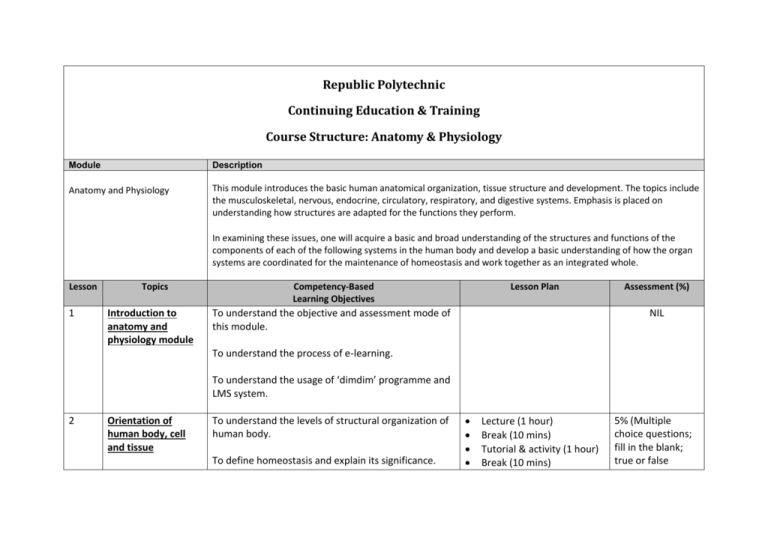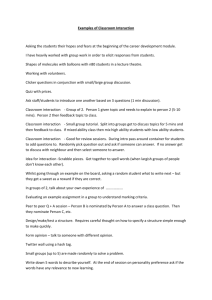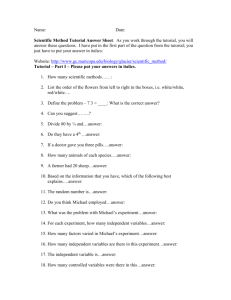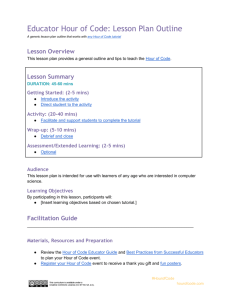Anatomy and Physiology
advertisement

Republic Polytechnic Continuing Education & Training Course Structure: Anatomy & Physiology Module Description Anatomy and Physiology This module introduces the basic human anatomical organization, tissue structure and development. The topics include the musculoskeletal, nervous, endocrine, circulatory, respiratory, and digestive systems. Emphasis is placed on understanding how structures are adapted for the functions they perform. In examining these issues, one will acquire a basic and broad understanding of the structures and functions of the components of each of the following systems in the human body and develop a basic understanding of how the organ systems are coordinated for the maintenance of homeostasis and work together as an integrated whole. Lesson 1 Topics Introduction to anatomy and physiology module Competency-Based Learning Objectives Lesson Plan To understand the objective and assessment mode of this module. Assessment (%) NIL To understand the process of e-learning. To understand the usage of ‘dimdim’ programme and LMS system. 2 Orientation of human body, cell and tissue To understand the levels of structural organization of human body. To define homeostasis and explain its significance. Lecture (1 hour) Break (10 mins) Tutorial & activity (1 hour) Break (10 mins) 5% (Multiple choice questions; fill in the blank; true or false questions) Discussion of tutorial questions and summary of lesson (30 mins) Quiz (10 mins) Lecture (1hour) Break (10 minutes) Tutorial (1 hour) Break (10 minutes) Tutorial (30 minutes) Quiz (10 minutes) 5% (Multiple choice questions; fill in the blank; true or false questions) Lecture (1hour) Break (10 minutes) 5% ( Multiple choice questions; To describe anatomical positional and directional terms. To explain the process of diffusion and osmosis. To understand the basic structures and functions of cells. To explain different types and basic functions of tissues. 3 Cardiovascular system – heart and blood vessels To describe the basic anatomy of the heart. To explain cardiac cycle. To explain the regulation of cardiac output. To understand the types of blood vessels To understand the factors that influence arterial blood pressure To understand the condition of coronary atherosclerosis and high blood pressure. 4 Respiratory system To identify the different organs of respiratory system. To understand the functions of respiratory system. To understand the mechanisms of inspiration and expiration. Tutorial (1 hour) Break (10 minutes) Tutorial (30 minutes) Quiz (10 minutes) fill in the blank; true or false questions) Lecture (1 hour) Break (10 mins) Tutorial & activity (1 hour) Break (10 mins) Discussion of tutorial questions and summary of lesson (30 mins) Quiz (10 mins) 5% (participation) To discuss the process of gas exchange between alveoli and blood. To understand the conditions of asthma and pneumonia. 5 Bone, skeleton and joints To understand the classification of bones To distinguish the difference between the axial and appendicular skeletons, To identify the basic structures of bones To identify and the major bones that compose the skull, vertebral column, thoracic cage, pectoral girdle, upper limb, pelvic girdle, and lower limb. To understand how bone response to mechanical stress To identify different types of joints To explain the factors influencing the stability of synovial joints 6 Muscle tissue and muscular system To identify different types of joint movements. To identify the degenerative changes of joint. To identify different types of muscle tissues. To understand the functions of muscles. Identify the major events of skeletal muscle fiber contraction. To differentiate different types of muscle contractions. To understand the importance of fascicle arrangement of muscles. To understand the lever system and bone-muscle relationship. To identify the major skeletal muscles of the body and their muscle actions. Lecture (1 hour) Break (10 mins) Tutorial & activity (1 hour) Break (10 mins) Discussion of tutorial questions and summary of lesson (30 mins) Quiz (10 mins) 5% (Multiple choice questions; fill in the blank; true or false questions) 7 Digestive system, nutrition and fluid balance To identify different organs of digestive system. To understand the functions of digestive system. To explain the process of digestion. To explain the mechanism of utilization of carbohydrate and fat by cells. Lecture (1hour) Break (10 minutes) Tutorial (1 hour) Break (10 minutes) Tutorial (30 minutes) Quiz (10 minutes) 5% (Reflection Journal) To understand the concept of energy balance and relate it to obesity. To explain the mechanism of body temperature regulation. 8 Nervous system and endocrine system To understand the functions of the nervous system. To identify the major lobes and functional areas of cerebral cortex. To identigy major regions of the brain stem. To identify common nervous system disorders, such as cerebrovascular accidents. To identify structural organisation of peripheral nervous system. To identify 12 pairs of cranial nerves and relate it to Bell’s palsy. Lecture (1hour) Break (10 minutes) Tutorial (1 hour) Break (10 minutes) Tutorial (30 minutes) Quiz (10 minutes) 5% (Multiple choice questions; fill in the blank; true or false questions) To identify spinal nerves and relate it to spinal pain. To identify the major endocrine glands, and list the hormones they secrete. To compare the two major pancreatic hormones and relate it to Diabetes Mellitus. 9 Practical session and To understand the process of measuring blood pressure using sphygmomanometer. group presentation 10 Tutorial sessions for previous lessons. Continual Assessment 1 – test (covers lessons 2nd 8th ) Continual Assessment 2 (2000 words essay) Practical 5% (Group presentation) 30% (Multiple choice questions and structured questions) 30%




